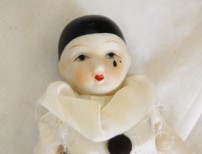Since I started learning about collecting and its relation to art this week I have been wondering in my few and far between idle moments: why do people collect things? What is it about human nature that makes people natural born collectors?
There are even words to describe certain types of collectors: an archtophilist collects teddy bears, a deltiologist collects postcards, a numismatist collects coins, a vecturist collects underground tickets (in the days before Oyster cards), and a clock collector is a horologist.
Some people regard themselves as serious collectors, and they collect almost as an occupation, spending a great deal of time researching their collection, a great deal of money buying new items for their collection and displaying a great deal of pride in their collections. This could be stamps, train numbers, Dr Who memorabilia, football cards, or vintage cars. Other people probably don’t even realise that they are collecting. I fit into this second category. I didn’t regard myself as a collector before I started thinking about collecting but looking around the house now I see that I collect quite a lot of things: cats, books, boots, hats and coats to name but a few. I love boots, I have so many different pairs of boots, such as my latest purchase purple velvet Dr Martens. I also have some green patent Dr Martens, some lovely big brown high heeled boots, my everyday red calf-length boots, some black knee-length lace up boots from Jigsaw, the list goes on.
So thinking about collections I asked my lovely friends to tell me what they collect or collected as children and here are the responses I got.
What my friends have collected:
‘Badges! I have no idea why I collected them, maybe because we had a ‘show’ day in the big hall at school once a year and you got to show off your collections on a table. I also collected Gollies, teddies and badges. All my gollies I have since sold and my badge collection was passed onto my son.’
‘Stamps. God knows why.’
‘Stamps – my grandpa had a brilliant collection, and we’d spend many happy hours sticking stamps in albums with those little sticky bits of tracing paper…’
‘Wade wimsies!’
‘Pencils and pens.’
‘Pogs, beanie babies, trolls. still have the beanie babies in a suitcase somewhere.’
‘Rubbers. Some of them smelly.’
‘Shells. I lived in near the coast. Now my daughter collects them!’
‘Stamps, and at one point snails.’
‘Books surprise surprise!’
‘Enid Blyton books – escapism I think! Can’t wait to share them with my children when they’re a bit older.’
‘Postcards – they had to be either ones sent to me or of places I was visiting, bought while I was there. I didn’t nick other peoples’ (my sisters’).’
‘Little furry monkeys playing band instruments!’
‘Stones and trolls!!!’
‘I collected stones (used to dig the garden for good ones), trolls, scented rubbers, monster in my pocket, sindy dolls, bouncy balls (especially really pretty glittery ones), old coins, The Sun sticker albums.’
‘Pierrot dolls because they were pretty, stamps.’
Are collectors a bit loopy?
Sigmund Freud didn’t see collecting as coming from motivations such as to record, learn about and preserve history; for relaxation; for showing off or for boredom. He stated rather that all collecting ties back to the time of toilet training. He suggested that the loss of control and what went down the toilet was a traumatic occurrence and that, therefore, the collector is trying to gain back control. We cannot deny that there is a slightly off-centre side to collecting (the stereotype collector with his greasy anorak, NHS glasses, and a propensity to dribble). The psychopathological form is described as hoarding. The ‘abnormality’ of the hoarder shows up in those instances where the excessive collecting behaviour interferes with an otherwise reasonable life. This can sometimes even include interference with the lives of others. Some theorists suggest that the behaviour associated with hoarding can be an extreme variation on compulsive buying. Compulsive buying, in turn, is said to be closely related to major depression, obsessive-compulsive disorder, and in particular, compulsive hoarding. It has been postulated that compulsive buying is influenced by a range of cognitive domains including deficits in decision-making, emotional attachments to objects, and erroneous beliefs about possessions, and other similar skewed beliefs.
Freud and those clever psychologists aside, we can’t really dispute that any sort of compulsive excessive behaviour becomes a medical health issue, but surely collecting for a hobby is just part of human nature? Perhaps it is the related to the nesting instinct, the desire to surround ourselves with objects that make us feel comfortable, relaxed and proud.
References:
McKinley, Mark B: The Psychology of Collecting (2007), http://www.talkingclocks.net/collecting.pdf [last accessed 19 October 2012]
Quora, www.quora.com/Why-do-people-collect-things [last accessed 19 October 2012]
Friends on Facebook, https://www.facebook.com/ [last accessed 19 October 2012]






